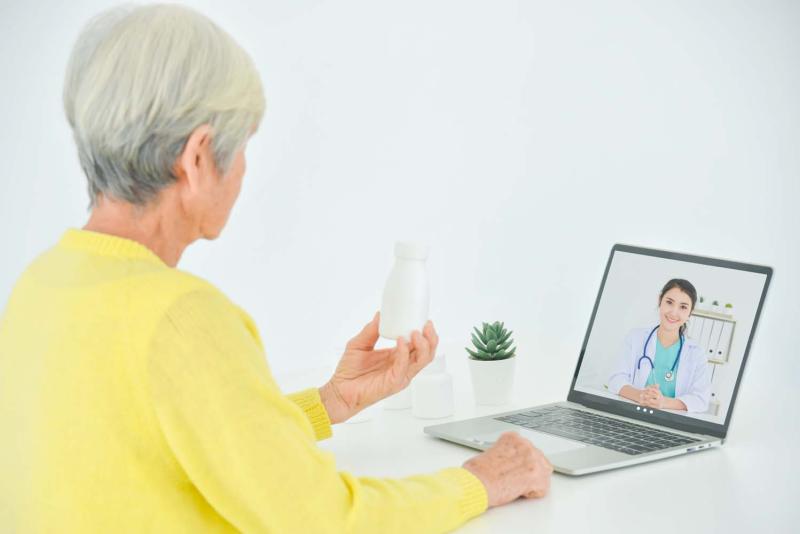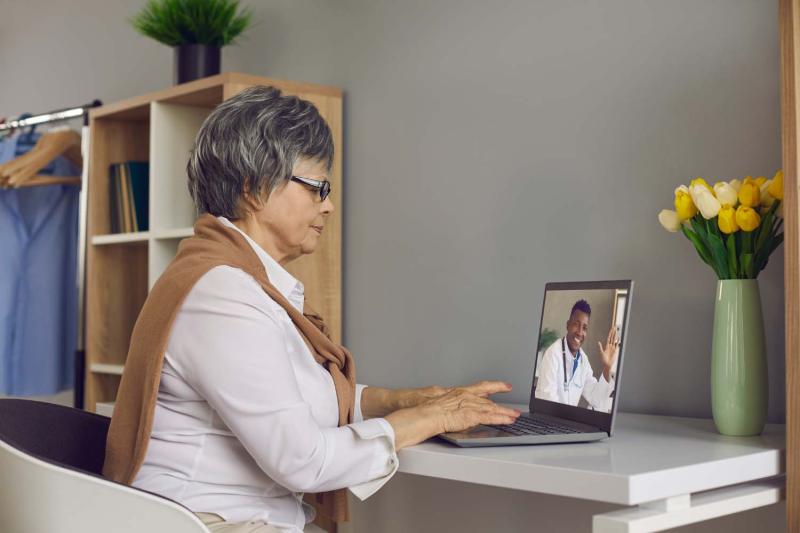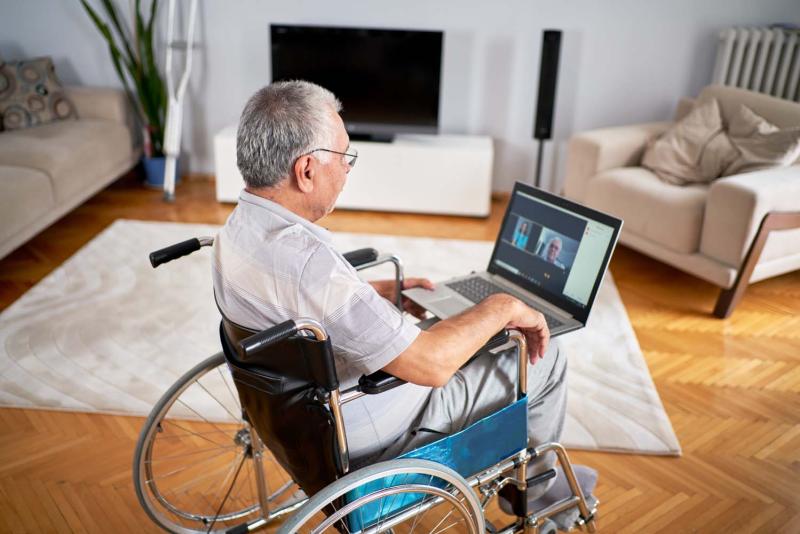Key points
-
Telehealth refers to the remote delivery of healthcare services using information and communication technologies.
-
Barriers to telehealth acceptance include lack of staff technical knowledge or skills, confidence, and role clarity when supporting teleconferences between care recipients with health professionals. Acceptance can also be affected by hardware, software, and infrastructure issues that can lead to staff frustration with the technology or the quality of the consultation.
-
Telehealth acceptance may be improved by providing training for care staff, ensuring regular use and practice, and emphasising the benefits of telehealth. These benefits include increased and more timely access to health care and a lower need for inconvenient and potentially unsafe transfers of people between locations.
-
Service providers can improve the use of telehealth by providing staff training, demonstrating leadership support for the technology, and by ensuring the appropriate infrastructure and equipment are in place to allow telehealth consultations to run smoothly.
Telehealth technology enables health professionals to conduct clinical consultations via phone and/or video rather than face-to-face. [1] The benefits of telehealth include reduced travel time and expenses for both patients and providers and increased access to healthcare services, often in real-time. [1] This can improve the equity of access to healthcare, especially for people who live further away from their care provider. [1] Telehealth can be as simple as a phone call or email, or can involve the transmission of image, voice, and textual data between two sites. [2] A consultation might use specialised software designed for this purpose, or employ popular videoconferencing technologies such as Skype, Zoom, or FaceTime. [3] Telehealth services funded by the Australian Medicare system were expanded during the COVID-19 pandemic. [4] Within Australian aged care services, telehealth enabled clinicians to continue to provide care despite the strict protective lockdowns and isolation measures in place at the time. [5] However, timely access to general practitioners and allied health practitioners continues to be a problem for many people, including those living in residential aged care facilities [6] and can lead to missed care, overuse of emergency departments, or unnecessary hospitalisations. [3] Transporting residents to external clinical appointments also carries risks, particularly when people have mobility issues, dementia, or are nearing the end of life. [7] Expanded rollout and uptake of telehealth in aged care may help reduce these risks. [6, 8]
This evidence theme on the acceptance and use of telehealth in aged care settings summarises one of the key issues we identified as part of a scoping review on human factors and technology in aged care. We identified eight studies on this topic. [7, 9-15] If you need more information on this topic, try using one of our PubMed searches below.
Factors that may reduce telehealth acceptance
Our review found that major barriers to telehealth acceptance may include limited technical skills, staff uncertainty around when to use telehealth, confidence in relaying information to health professionals, and the useability of the technology.
Staff skills, knowledge, uncertainty or lack of confidence
The included studies reported that:
-
Some staff lacked the technical confidence to conduct telehealth consultations and were more likely to use it with the support of more experienced team members. [9]
-
Despite feeling professionally isolated and in need of clinical advice, residential aged care staff might hesitate to use telehealth for fear of disturbing external clinicians unnecessarily or being perceived as incompetent. [9] This was particularly evident when there was a power imbalance between the staff member and the consulting clinician.
-
Some nurses expressed uncertainty in having to conduct physical assessments on behalf of remote health professionals and might lack confidence in relaying the information they needed to form a clinical judgement. These concerns might be reduced over time with greater experience in telehealth consultations and by becoming more familiar with the consulting clinician’s communication style. [7]
-
Some aged care staff expressed uncertainty about their roles during telehealth consultations. For example, consulting doctors might expect enrolled nurses to relay information that goes beyond their scope of practice. [7]
-
Some residents were less engaged in online consultations due to cognitive or sensory impairments. [7] Residents with dementia were at times confused by seeing their own faces on the computer screen. [7]
-
In a home care study, staff felt they lacked the training and knowledge to use telehealth for managing the care of people with depression. [10] In this same US-based study, staff reported fearing for their health and safety when taking expensive telehealth equipment into the homes of people living in unhygienic conditions or insecure neighbourhoods. [10]
-
The most significant barrier to home-based telehealth consultations in one US study was the lack of reimbursement under the fee-for-service Medicare system for providing care via telehealth. [10]
Technology-related issues
Some studies highlighted specific technology-related considerations that may impact how individuals engage with telehealth. They reported that:
-
Some older adults and their families needed reassurance that the telehealth connection was private and secure, that consultations were not being recorded, and that their information remained confidential. [11, 12] Some people were concerned that they could not easily identify the clinician at the other end, perhaps due to bad lighting. [12]
-
Health professionals reported issues relating to poor data and equipment integration and inconsistent documentation of telehealth sessions which impacted telehealth acceptance. [13] For example, a remote clinician might not be able to access locally stored clinical records, including lists of medications. This information would then have to be read aloud by staff. [7]
-
Technical problems might reduce useability and acceptance. These included poor audio-visual quality, low volume, unstable internet connections (especially in rural and remote areas), and the burden of setting up and troubleshooting technical issues. [9, 13, 14] Poor visual quality could make it difficult to conduct appropriate visual assessments of certain conditions. [7]
-
In one study, older people with cognitive decline or physical frailty found it difficult to engage with video-conferencing technology using iPads. They found the iPads ‘too heavy’ to hold independently, icons challenging to press, and calls were sometimes impacted by hearing impairments, despite the volume being at maximum level. [11]
Factors that may increase telehealth acceptance
Factors with the potential to increase telehealth acceptance include positive perceptions or beliefs in telehealth benefits and having strategies in place (e.g., staff training) to address potential barriers.
Positive perceptions about the use of telehealth technology
Across the included studies, aged care staff were more likely to support the use of telehealth when they could perceive its benefits for those in their care as well as for themselves. They reported that:
-
For some residential aged care nurses, telehealth provided an opportunity for greater autonomy and responsibility as they became the ‘eyes, ears, and hands’ of the remote clinician. They reported feeling more empowered in their role when using this technology. [7, 14]
-
Staff perceived a telehealth service linking residential aged care nursing staff and emergency department clinicians as creating better communication, trust, and care continuity for residents and their families. [14]
-
Perceiving an advantage of telehealth over alternative approaches to accessing care was also important for acceptance. For example, staff who found telehealth improved the speed at which those in their care were seen by clinicians were shown to be more willing to engage with the technology. [9]
-
Staff members who advocate for the benefits of telehealth can be effective in encouraging other staff to trial or use it. [9, 10]
-
In the home care setting, visiting nurses were more willing to adopt telehealth consultations when there was adequate acceptance (or ‘buy-in’) from care recipients, family/informal caregivers, and general practitioners. [10]
Telehealth training and regular practice for staff
Aged care staff emphasised the importance of having training in telehealth to increase their skills and confidence. [9, 14, 15] Some staff reported that the more frequently they used videoconferencing technology for telehealth consultations, the more confident they became in running the sessions. This increase in confidence led to increased uptake of telehealth. [7, 9, 14]
Organisational support
Organisational support for telehealth could increase its acceptance. For example:
-
Organisations providing infrastructure and essential equipment such as telehealth units or rooms, devices with good quality audiovisual properties, and stable network connections had better telehealth acceptance. [13, 14]
-
Aged care workplaces with a supportive culture and technology leadership had a more successful uptake of telehealth services. This might also translate into positive and fulfilling workplace experiences for staff. [7, 9]
To enhance the acceptance of telehealth by staff, care recipients, and their families, service providers can:
-
Provide staff training on the use of telehealth, including the use of different technologies and devices.
-
Provide clear guidance on staff roles and scope of practice when involved in telehealth consultations with health professionals from outside the organisation.
-
Ensure infrastructure is in place to support telehealth use to prevent frustrating lag times and internet dropouts, as well as the necessary equipment to provide a teleconferencing service.
-
Have a space dedicated to telehealth within the residential aged care facility to minimise disturbance and noise whilst conducting telehealth consultations.
This evidence theme is based on a scoping review intended to map the published research in this area. Our findings reflect the current state of the evidence which we note is limited in breadth and quality. Some of the studies associated with this theme also reported on staff training needs and concerns about privacy and cybersecurity. We present these findings as separate Human Factors Evidence Themes.
- Australian Digital Health Agency. Telehealth [Internet]. ADHA; 2023 [cited 2023 Mar 24]. Available from: https://www.digitalhealth.gov.au/healthcare-providers/initiatives-and-programs/telehealth
- Royal Australian College of General Practitioners. Telehealth video consultations guide [Internet]. East Melbourne, Vic.: RACGP; 2019 [Cited 2023 Mar 24]. Available from: https://www.racgp.org.au/getmedia/c51931f5-c6ea-4925-b3e8-a684bc64b1d6/Telehealth-video-consultation-guide.pdf.aspx.
- Powell KR, Winkler AE, Liu J, Alexander GL. A mixed-methods analysis of telehealth implementation in nursing homes amidst the COVID-19 pandemic. J Am Geriatr Soc. 2022 Dec;70(12):3493-3502.
- World Health Organization. Implementing telemedicine services during COVID-19: Guiding principles and considerations for a stepwise approach [Internet]. WHO Western Pacific; 2020 [cited 2023 Mar 24]. Available from: https://www.who.int/publications/i/item/WPR-DSE-2020-032.
- Dai Z, Sezgin G, Li J, Franco GS, McGuire P, Datta S, Pearce C, McLeod A, Georgiou A. Telehealth utilisation in residential aged care facilities during the COVID-19 pandemic: A retrospective cohort study in Australian general practice. J Telemed Telecare. 2022 May 11:1357633X221094406.
- Royal Commission into Aged Care Quality and Safety. Final report: Care, dignity and respect [Internet]. Australian Government; 2022 [cited 2023 Mar 24]. Available from: https://agedcare.royalcommission.gov.au/publications/final-report
- Qi Tan AJ, Chua WL, McKenna L, Chin Tan LL, Lim YJ, Liaw SY. Enablers and barriers to nurse-facilitated geriatric teleconsultations in nursing homes: A qualitative descriptive multi-site study. Age Ageing. 2022 Dec 5;51(12):afac268.
- Roberts B. Aged care sector stubbornly resisting telehealth uptake in COVID-normal phase. [Internet]. Australia: Aged Care News; 2022 Jun 1 [cited 2023 Mar 24]. Available from: https://agedcarenews.com.au/2022/06/01/aged-care-sector-stubbornly-resisting-telehealth-uptake-in-covid-normal-phase/.
- Newbould L, Ariss S, Mountain G, Hawley MS. Exploring factors that affect the uptake and sustainability of videoconferencing for healthcare provision for older adults in care homes: A realist evaluation. BMC Med Inform Decis Mak. 2021;21(1):13.
- Kim E, Gellis ZD, Bradway C, Kenaley B. Key determinants to using telehealth technology to serve medically ill and depressed homebound older adults. J Gerontol Soc Work. 2019;62(4):451-474.
- Moyle W, Jones C, Murfield J, Liu F. 'For me at 90, it's going to be difficult': Feasibility of using iPad video-conferencing with older adults in long-term aged care. Aging Ment Health. 2020 Feb;24(2):349-352.
- Read Paul L, Salmon C, Sinnarajah A, Spice R. Web-based videoconferencing for rural palliative care consultation with elderly patients at home. Support Care Cancer. 2019 Sep;27(9):3321-3330.
- Powell KR, Winkler AE, Liu J, Alexander GL. A mixed-methods analysis of telehealth implementation in nursing homes amidst the COVID-19 pandemic. J Am Geriatr Soc. 2022 Dec;70(12):3493-3502.
- Sunner C, Giles MT, Kable A, Foureur M. Does telehealth influence the decision to transfer residents of residential aged care facilities to emergency departments? A scoping review. Int J Older People Nurs. 2023 Jan;18(1):e12517.
- Williams KN, Shaw CA, Perkhounkova Y, Hein M, Coleman CK. Satisfaction, utilization, and feasibility of a telehealth intervention for in-home dementia care support: A mixed methods study. Dementia (London). 2021 Jul;20(5):1565-1585.
Connect to PubMed evidence
This PubMed topic search is focused on research conducted in aged care settings (i.e., home care and residential aged care). You can choose to view all citations or free full-text articles.


